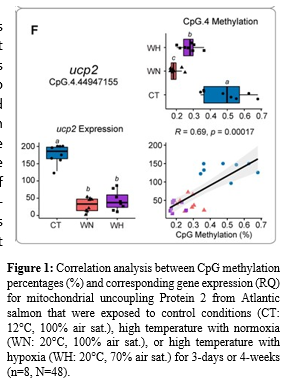TO WHAT EXTENT DO ‘HIGH’ WATER TEMPERATURES AFFECT THE PHYSIOLOGY OF ATLANTIC SALMON?
Increases in average water temperatures and decreases in water oxygen levels (hypoxia), and more frequent and extreme warmin g events (i.e., heat waves), are occurring with climate change. Thus, there is an urgent need to understand the effects of prolonged
and short-term warming on the physiology of cultured fishes, including Atlantic salmon ( Salmo salar). This is particularly true with regard to Tasmania and Atlantic Canada where water temperatures have approached or exceeded 20°C, in combination with hyp oxia, and negative effects on production and fish health ( including large-scale mortalities) have been reported.
Over the past few years, we have used a multilevel (e.g.,
whole animal , biochemical, genomic, epigenetic) approach, and several experimental paradigms, to understand how high temperatures alone, and
when combined with moderate hypoxia (60-70% air sat.), impac t salmon physiology and
production characteristics under realistic temperature scenarios (e.g.,
using an ITMAX test ; a 1°C
increase week-1 from 10°C ).
In this presentation, we will show that while stress gene expression in salmon begins to be affected at 16°C, and feeding decreases dramatically as temperatures approach 20°C, there is little/n o evidence that this temperature, even when prolonged or combined with moderate hypoxia, results in mortalities . The salmon’s capacity to mount an innate immune response is not compromised at these temperatures and
plasma cortisol levels (indicative of a secondary stress response) do not increase until 21-22°C . Finally, in lab-based experiments, mortalities only begin when the fish reached
21°C , and even at 23°C mortalities are only ~ 30% .
Through this research, we have also been able to identify epigenetic and genomic markers of temperature and hypoxia tolerance in salmon (e.g. Figure 1), and have identified populations/ families of salmon that have critical thermal maximum (CTMAX) and ITMAX
values of ~28°C and 25°C, re spectively. This should assist in the development genetic and other markers for use in selecting fish that are more tolerant of these conditions and for evaluating fish health .
